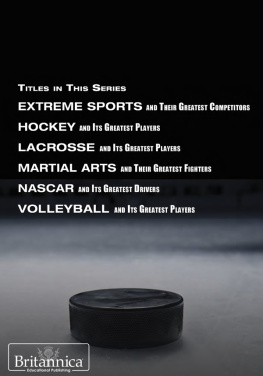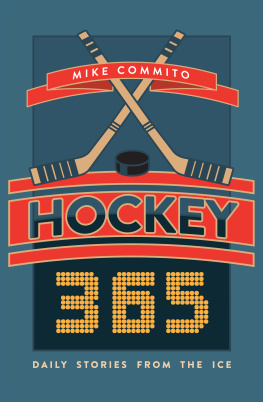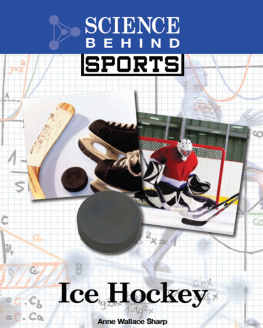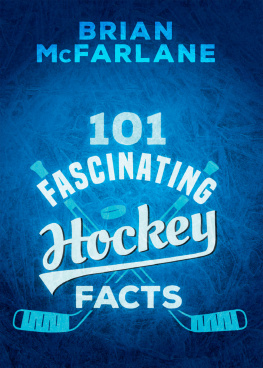

Published in 2015 by Britannica Educational Publishing (a trademark of Encyclopdia Britannica, Inc.) in association with The Rosen Publishing Group, Inc.
29 East 21st Street, New York, NY 10010
Copyright 2015 by Encyclopdia Britannica, Inc. Britannica, Encyclopdia Britannica, and the Thistle logo are registered trademarks of Encyclopdia Britannica, Inc. All rights reserved.
Rosen Publishing materials copyright 2015 The Rosen Publishing Group, Inc. All rights reserved
Distributed exclusively by Rosen Publishing.
To see additional Britannica Educational Publishing titles, go to rosenpublishing.com.
First Edition
Britannica Educational Publishing
J. E. Luebering: Director, Core Reference Group
Anthony L. Green: Editor, Comptons by Britannica
Rosen Publishing
Hope Lourie Killcoyne: Executive Editor
Additional content supplied by Kristen Rajczak
Nelson S: Art Director
Brian Garvey: Designer
Cindy Reiman: Photography Manager
Library of Congress Cataloging-in-Publication Data
Hockey and its greatest players/edited by Hope Lourie Killcoyne.First Edition.
pages cm.((Inside Sports))
Distributed exclusively by Rosen PublishingT.p. verso.
Includes bibliographical references and index.
ISBN 978-1-6227-5587-5 (eBook)
1. HockeyHistoryJuvenile literature. 2. Hockey playersRating of. I. Killcoyne, Hope Lourie.
GV847.25.H63 2015
796.96264dc23
2014023132
On the cover, page 3: Jonathan Toews of the Chicago Blackhawks. Jonathan Daniel/Getty Images
Pages 67, 10, 23, 40, 53, 70, 71, 74, 77, 78 iStockphoto.com/Aksonov; pp. 16, 17, 20, 21, 33, 34, 35, 37, 42, 43, 49 iStockphoto.com/willierossin; back cover, interior pages background image iStockphoto.com/francisblack; silhouettes iStockphoto.com/XonkArts.
CONTENTS
I n 2010, Patrick Kane of the Chicago Blackhawks made a championship-winning goal that almost no one in the arena could seeincluding some of the players on the ice. The puck zipped past Philadelphia Flyers goalie Michael Leighton into the right corner of the net so fast and at such an angle that only a replay could confirm the Blackhawks win. The speed and abruptness of Kanes goal highlights the changeable, exciting nature of ice hockey. It is the fastest of all team sports.

Right wing Patrick Kane raises the Stanley Cup in triumph after his teams championship win. Bruce Bennett/Getty Images
Ice hockey has been described as a combination of blood, sweat, and beauty. More than any other team sport, ice hockey is a game of motion: even when the action is whistled to a stop, the momentum keeps flowing. The basic plays of the game are repeated endlessly, but the players are never able to skate in quite the same patterns, and the sequences of their moves keep changing. Fights are common, but even without the violence, ice hockey is a rugged game that demands superbly conditioned athletes. Serious injuries can result from the sheer speed of the action on the ice. Blood has hit the ice next to a players skates many times, and players often sport gap-toothed grins due to teeth knocked out over the course of their careers. While at times controversial, to avid fans ice hockeys violence is part of the sports tradition and shows passion and ferocity in players.
Canada has long been known to produce an extraordinary number of talented players, perhaps because the professional game was developed on Canadian ice. In addition, Canada in particular is known for having an exceptional number of passionate and enthusiastic fans. Ice hockey is so beloved in Canada that it is the countrys national winter sport.
More than one million people play hockey in leagues around the worldand millions more watch them. From the development of the National Hockey League (NHL) to the stats of the greatest hockey players of all time, theres so much to learn about ice hockey. (For starters, for a game in which bare-knuckle brawls have become expected, one of the prestigious prizes is a trophy for the most gentlemanly player.)
A lthough casual games were played on makeshift ice skates in northern Europe during the Middle Ages, it wasnt until the 19th century that the modern sport of ice hockey truly began to emerge. Elements of ice hockey were influenced by the English game of field hockey and by lacrosse, a North American Indian game played with a stick, ball, and net. In the early 1800s, some North American Indians also played a game using field tools that were curved at the lower end, a derivation of the Irish and Scottish settlers game of hurley, or hurling. This game evolved into an informal game on ice called shinny or shinty. French explorers who watched the Indians improvised ball-and-stick games attached the French word for the similarly shaped shepherds crook, hoquethockey.

This image from about 490 BCE shows a hockey-like sport played in Greece. Gianni Dagi Orti/The Art Archive at Art Resource, NY
During the 1700s and 1800s, moving about the ice on skates made with sharpened animal bones was a popular pastime, both in Europe and Canada. By the mid-1800s, a crude form of ice hockey was being played in Canadas frozen harbors by British troops stationed there. Rules and organization of the popular games were not far off.
E STABLISHING THE G AME
Nineteenthcentury Canadian lawyer, engineer, and athletic innovator James Creighton, a native of Halifax, Nova Scotia, is often credited with both the early rules of hockey and the organization of the first official, recorded game. As a boy, he and his friends had played pick-up games of shinny out on the ice. They would make the playing surface as long as needed for the number of people playing and choose the number of points it would take to win. Their games continued into their adult years as in 1875, the first indoor ice rink in Canada opened in Montreal, Quebec. Called the Victoria Skating Rink, it was used for figure skating competitions, at which Creighton sometimes served as a judge.
Three Canadian cities claim to be the locale of the first formal hockey game: Halifax; Montreal; and Kingston, Ontario. It is believed that some form of the game was being played in Kingston as early as 1830, twenty years before Creightons birth. However, it was Creighton who organized the first recorded game. It was played at the Victoria Skating Rink on March 3, 1875. Members of the Montreal Football Club and students from McGill University formed two teams of nine players each. Creighton had limited each team to nine players due to the size of the indoor rink. That was the first important change the game underwent toward becoming the modern game.



















